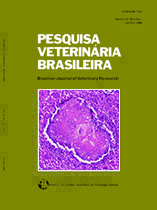 |
|
|
|
Year 2017 - Volume 37, Number 11
|

|
Macroscopic and histological findings of bovine cysticercosis, 37(11):1220-1228
|
ABSTRACT.- Panziera W., Vielmo A., Bianchi R.M., Andrade C.P., Pavarini S.P., Sonne L., Soares J.F. & Driemeier D. 2017. [Macroscopic and histological findings of bovine cysticercosis.] Aspectos macroscópicos e histológicos da cisticercose bovina. Pesquisa Veterinária Brasileira 37(11):1220-1228. Setor de Patologia Veterinária, Faculdade de Veterinária, Universidade Federal do Rio Grande do Sul, Av. Bento Gonçalves 9090, Prédio 42505, Porto Alegre, RS 91540-000, Brazil. E-mail: davetpat@ufrgs.br
Bovine cysticercosis is an important zoonotic parasitic disease with high prevalence in several regions of Brazil. Considering the need of improvement of the accuracy of diagnosis of these lesions, as well as the difficulty of classification of the cysts, this study aimed to correlate gross and histopathological changes of bovine cysticercosis and to use polymerase chain reaction (PCR) as an aid in their identification. Cystic and nodular lesions from cattle, grossly compatible with cysticercosis, were sampled in slaughterhouses from Rio Grande do Sul State. Lesions were allotted in one of the following groups. Group 1: viable cysticercus; Group 2 (subdivided 2a e 2b): degenerating cysticercus with a potentially viable scolex; and Group 3: dead cysticercus (mineralized). The gross and microscopic aspects of every cysticerci of each group were compared. Two hundred and thirty two cysts and nodules compatible with cysticercus were sampled from 127 bovine. Twenty six of those lesions were tested with PCR. Out of 127 cattle, 46 (36.2%) had more than one cyst and the remaining 81 (63.8%) had on cyst each. Myocardium was the most frequently involved anatomical site (55.9%), followed by masseter muscle (22.8%). When there was more than one organ involved in the same bovine, myocardium a master muscle sum up 11 cases (8.6%). In general, the average of cysticercosis frequency was 10-15%. However the average in some cattle lots was in excess of 50%, 80% and 90%. Morphologically, 232 cysticerci were classified in three groups. In Group 1, 23 cysticerci (9.9%) were considered viable and were characterized by cysts of translucent or slightly opaque wall, containing clear and a white point (scolex) within the cyst. Histologically, the cysts consisted of a membrane from which a scolex of Taenia saginata invaginated. One hundred and fifty six cysts (67.2%) were allotted in Group 2; grossly these cysts revealed two different morphological patterns. In 111 (71.1%) cases of Group 2 (Group 2a) nodular caseous lesions were observed. Histologically, the cysts were characterized by nodules consisting by a central area containing the scolex and membrane, both degenerated, and caseous necrosis. In the remaining 45 (28.9%) cases of Group 2 (Group 2b), lesions were also caseous; however, at cut surface the cysts had a central hole amidst the caseous material. The microscopic aspect of the 45 cysts included in the second was similar to that of the first pattern. However in eight (17.8%) of the 45 cysts only a viable parasitic membrane was observed and in one cyst the membrane and viable scolex were observed. In the remaining 36 cases (80%), the cysts consisted of a central area containing both degenerated membrane and scolex, and caseous necrosis. In Group 3, 53 dead cysts (mineralized) (22.9%) were found among the total of 232 cysts. The gross aspect of these cysticerci was characterized by yellow form nodules which crumbled when cut. Histologically nodules were observed with marked central area of mineralization surrounded by granulomatous inflammatory response. Twenty four of the twenty cysts examined by PCR were positive for Cysticercus bovis and two of them were negative. One of the negatives was part of Group 2 (degenerated cysts) and the other one of the Group 3 (dead mineralized cysts). The correlation between gross and microscopic aspects of the second morphologic aspect of the Group 2 demonstrated that this subset represents a major complicating factor in interpretation, since a large number of these cysts reveal characteristics of viability. Grossly, these cysticerci might be identified when cut, since a hole in the central area will be observed aiding in recognizing his lesions. |
| |
|
|
| |
|
 |